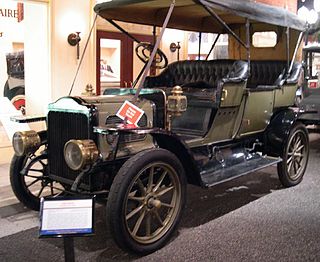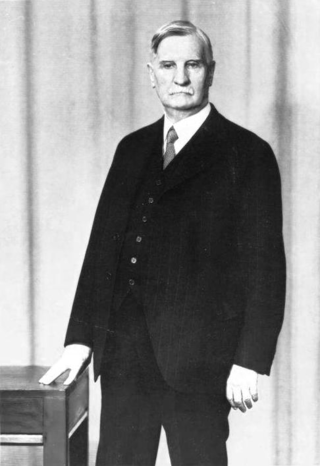S.R. Bailey & Company was an American manufacturer of electric automobiles from 1905 until 1916. They were based in Amesbury, Massachusetts, an early capital of automobile manufacture prior to the Great Depression.
Contents


S.R. Bailey & Company was an American manufacturer of electric automobiles from 1905 until 1916. They were based in Amesbury, Massachusetts, an early capital of automobile manufacture prior to the Great Depression.


The company, based in Amesbury, Massachusetts, originally manufactured car bodies. Amesbury was a major center of car body manufacturers prior to the Great Depression. In 1907, S.R. Bailey began the production of automobiles. The brand name was Bailey, sometimes with the addition of Electric. 1916 was the last year of production, when the enterprise went into bankruptcy. Assets were purchased by Biddle and Smart, manufacturer of automobile bodies, in 1917. [1]
The company produced electric cars. The range was given as 80 to 100 miles at a constant speed of 15 m.p.h. The batteries were mounted below the body. [2]

| Year | Model | Wheelbase (cm) | Make |
|---|---|---|---|
| 1908–1909 | 193 | Queen Victoria Phaeton | |
| 1910–1911 | 201 | Queen Victoria Phaeton | |
| 1912–1913 | 208 | Queen Victoria Phaeton | |
| 1912–1913 | 269 | Roadster | |
| 1914 | Model E | 208 | Roadster 2-seater |
| 1914 | Model EVP | 208 | Victoria 2-seater |
| 1914 | Model F | 284 | Roadster 2-seater |
| 1914 | Model F | 335 | Roadster 4-seater |
| 1915 | Model F | 208 | Cabriolet 3-seater |
| 1915 | Model F | 284 | Roadster 2-seater |
| 1915 | Model F | 335 | Touring Car 4-seater |
| 1916 | Model F | 284 | Roadster 2-seater |
| 1916 | Model F | 335 | Roadster 4-seater |

The Franklin Automobile Company was a marketer of automobiles in the United States between 1902 and 1934 in Syracuse, New York. Herbert H. Franklin, the founder, began his career in the metal die casting business before establishing his automobile enterprise. Controlled by Herbert H. Franklin it had very few other significant shareholders. Franklin bought its vehicles from the H. H. Franklin Manufacturing Company which was only moderately profitable and frequently missed dividends on common stock.

Marmon Motor Car Company was an American automobile manufacturer founded by Howard Carpenter Marmon and owned by Nordyke Marmon & Company of Indianapolis, Indiana, US. It produced luxury automobiles from 1902 to 1933.

An antique car is an automobile that is an antique. Narrower definitions vary based on how old a car must be to qualify. The Antique Automobile Club of America defines an antique car as over 25 years of age. However, the legal definitions for the purpose of antique vehicle registration vary widely. The antique car era includes the Veteran era, the Brass era, and the Vintage era, which range from the beginning of the automobile up to the 1930s. Later cars are often described as classic cars. In original or originally restored condition antiques are very valuable and are usually either protected and stored or exhibited in car shows but are very rarely driven.

The Brass Era is an American term for the early period of automotive manufacturing, named for the prominent brass fittings used during this time for such features as lights and radiators. It is generally considered to encompass 1896 through 1915, a time when cars were often referred to as horseless carriages.

A steam car is a car (automobile) propelled by a steam engine. A steam engine is an external combustion engine (ECE), whereas the gasoline and diesel engines that eventually became standard are internal combustion engines (ICE). ECEs have a lower thermal efficiency, but carbon monoxide production is more readily regulated.

The Peerless Motor Car Company was an American automobile manufacturer that produced the Peerless brand of motorcars in Cleveland, Ohio, from 1900 to 1931. One of the "Three Ps" – Packard, Peerless, and Pierce-Arrow – the company was known for building high-quality luxury automobiles. Peerless popularized a number of vehicle innovations that later became standard equipment, including drum brakes and the first enclosed-body production cars.

Edward Gowen Budd was an American inventor and businessman.

The J. G. Brill Company manufactured streetcars, interurban coaches, motor buses, trolleybuses and railroad cars in the United States for nearly 90 years, hence the longest-lasting trolley and interurban manufacturer. At its height, Brill was the largest manufacturer of streetcars and interurban cars in the US and produced more streetcars, interurbans and gas-electric cars than any other manufacturer, building more than 45,000 streetcars alone.

Development of the automobile started in 1672 with the invention of the first steam-powered vehicle, which led to the creation of the first steam-powered automobile capable of human transportation, built by Nicolas-Joseph Cugnot in 1769. Inventors began to branch out at the start of the 19th century, creating the de Rivaz engine, one of the first internal combustion engines, and an early electric motor. Samuel Brown later tested the first industrially applied internal combustion engine in 1826. Only two of these were made.

The Owen Magnetic was a pioneering American brand of hybrid electric luxury automobile manufactured between 1915 and 1922. Car models of the brand were notable for their use of an electromagnetic transmission and were early examples of an electric series hybrid drivetrain. The manufacture of the car was sponsored by R.M. Owen & Company of New York, New York. The car was built in New York City in 1915, in Cleveland, Ohio, between 1916 and 1919 and finally in Wilkes-Barre, Pennsylvania, in 1920 and 1921.

In the United States, the automotive industry began in the 1890s and, as a result of the size of the domestic market and the use of mass production, rapidly evolved into the largest in the world. The United States was the first country in the world to have a mass market for vehicle production and sales and is a pioneer of the automotive industry and mass market production process. During the 20th century, global competitors emerged, especially in the second half of the century primarily across European and Asian markets, such as Germany, France, Italy, Japan and South Korea. The U.S. is currently second among the largest manufacturers in the world by volume.

The Rauch & Lang Carriage Company was an American electric automobile manufactured in Cleveland, Ohio, from 1905 to 1920 and Chicopee Falls, Massachusetts, from 1920 to 1932.

James Cunningham, Son and Company was an American business based in Rochester, New York, initially manufacturing horse-drawn coaches, that from 1908 onward developed and produced automobiles. The Cunningham company was a pioneer in automobile production, credited with being one of the world's first developers and manufacturers of automobiles and, in 1916, one of the first carmakers to produce an American V8 engine automobile. Its Cunningham automobile was a pioneering American production automobile.

Clinton Edgar Woods was an electrical and mechanical engineer, inventor, manufacturer of automobiles in Chicago and New York City. He was the author of one of the first books on electric vehicles, and an early management author.

The automotive industry in Sweden is mainly associated with passenger car manufacturers Volvo Cars and Saab Automobile but Sweden is also home of two of the largest truck manufacturers in the world: AB Volvo and Scania AB. The automotive industry is heavily dependent on export as some 85 percent of the passenger cars and 95 percent of the heavy vehicles are sold outside of Sweden. The automotive industry and its sub-contractors is a major part of Swedish industry. In 2011 around 110,000 people were employed and the export income of 150 billion SEK accounted for 12 per cent of Sweden's export income. During 2009 128,738 passenger cars and 27,698 heavy vehicles were built in Sweden. Koenigsegg is also a famous Swedish company which makes some of the fastest cars in the world, but also some of the most expensive. They currently produce models such as the Jesko, Gemera, and CC850.
The automotive industry in Massachusetts refers to a period of time from 1893 to 1989 when automobiles were manufactured in the Commonwealth of Massachusetts commercially. In the early years, the state produced more automobiles than Detroit, Michigan. During the 20th century, General Motors and the Ford Motor Company were producing automobiles at the Framingham Assembly and Cambridge Assembly, respectively.
The John B. Judkins Company of West Amesbury, Massachusetts, carriage and automobile body manufacturers built their first automobiles in the 1890s. West Amesbury, since re-named Merrimac, was an early center of American carriage-building.
The Walker Body Company, a former carriage manufacturer based in Amesbury, Massachusetts, began manufacturing metal automobile bodies in 1911. It went bankrupt in 1930. The manufacturing site remains as the Walker Body Company Factory.
Biddle and Smart was a manufacturer of carriages and then automobile bodies based in Amesbury, Massachusetts. It started as a successful carriage manufacturer before making the transition to auto body manufacturer in 1905.